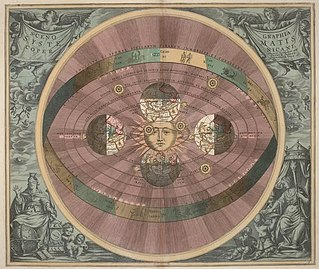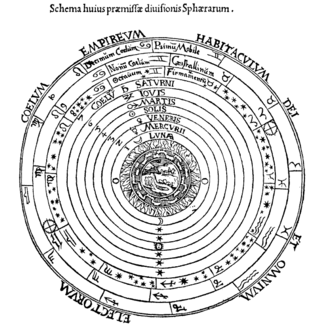
The ecliptic or ecliptic plane is the orbital plane of Earth around the Sun. From the perspective of an observer on Earth, the Sun's movement around the celestial sphere over the course of a year traces out a path along the ecliptic against the background of stars. The ecliptic is an important reference plane and is the basis of the ecliptic coordinate system.

Hipparchus was a Greek astronomer, geographer, and mathematician. He is considered the founder of trigonometry, but is most famous for his incidental discovery of the precession of the equinoxes. Hipparchus was born in Nicaea, Bithynia, and probably died on the island of Rhodes, Greece. He is known to have been a working astronomer between 162 and 127 BC.

The zodiac is a belt-shaped region of the sky that extends approximately 8° north and south of the ecliptic, the apparent path of the Sun across the celestial sphere over the course of the year. Also within this zodiac belt appear the Moon and the brightest planets, along their orbital planes. The zodiac is divided along the ecliptic into 12 equal parts ("signs"), each occupying 30° of celestial longitude. These signs roughly correspond to the astronomical constellations with the following modern names: Aries, Taurus, Gemini, Cancer, Leo, Virgo, Libra, Scorpio, Sagittarius, Capricorn, Aquarius, and Pisces.

In astronomy, the ecliptic coordinate system is a celestial coordinate system commonly used for representing the apparent positions, orbits, and pole orientations of Solar System objects. Because most planets and many small Solar System bodies have orbits with only slight inclinations to the ecliptic, using it as the fundamental plane is convenient. The system's origin can be the center of either the Sun or Earth, its primary direction is towards the March equinox, and it has a right-hand convention. It may be implemented in spherical or rectangular coordinates.

In astronomy, axial precession is a gravity-induced, slow, and continuous change in the orientation of an astronomical body's rotational axis. In the absence of precession, the astronomical body's orbit would show axial parallelism. In particular, axial precession can refer to the gradual shift in the orientation of Earth's axis of rotation in a cycle of approximately 26,000 years. This is similar to the precession of a spinning top, with the axis tracing out a pair of cones joined at their apices. The term "precession" typically refers only to this largest part of the motion; other changes in the alignment of Earth's axis—nutation and polar motion—are much smaller in magnitude.
In astronomy, an epoch or reference epoch is a moment in time used as a reference point for some time-varying astronomical quantity. It is useful for the celestial coordinates or orbital elements of a celestial body, as they are subject to perturbations and vary with time. These time-varying astronomical quantities might include, for example, the mean longitude or mean anomaly of a body, the node of its orbit relative to a reference plane, the direction of the apogee or aphelion of its orbit, or the size of the major axis of its orbit.
Thābit ibn Qurra, was a polymath known for his work in mathematics, medicine, astronomy, and translation. He lived in Baghdad in the second half of the ninth century during the time of the Abbasid Caliphate.

Heliocentrism is a superseded astronomical model in which the Earth and planets revolve around the Sun at the center of the universe. Historically, heliocentrism was opposed to geocentrism, which placed the Earth at the center. The notion that the Earth revolves around the Sun had been proposed as early as the third century BC by Aristarchus of Samos, who had been influenced by a concept presented by Philolaus of Croton. In the 5th century BC the Greek Philosophers Philolaus and Hicetas had the thought on different occasions that the Earth was spherical and revolving around a "mystical" central fire, and that this fire regulated the universe. In medieval Europe, however, Aristarchus' heliocentrism attracted little attention—possibly because of the loss of scientific works of the Hellenistic period.
Theon of Alexandria was a Greek scholar and mathematician who lived in Alexandria, Egypt. He edited and arranged Euclid's Elements and wrote commentaries on works by Euclid and Ptolemy. His daughter Hypatia also won fame as a mathematician.

The celestial spheres, or celestial orbs, were the fundamental entities of the cosmological models developed by Plato, Eudoxus, Aristotle, Ptolemy, Copernicus, and others. In these celestial models, the apparent motions of the fixed stars and planets are accounted for by treating them as embedded in rotating spheres made of an aetherial, transparent fifth element (quintessence), like gems set in orbs. Since it was believed that the fixed stars did not change their positions relative to one another, it was argued that they must be on the surface of a single starry sphere.

Abū ʿAbd Allāh Muḥammad ibn Jābir ibn Sinān al-Raqqī al-Ḥarrānī aṣ-Ṣābiʾ al-Battānī, usually called al-Battānī, a name that was in the past Latinized as Albategnius, was an astronomer, astrologer and mathematician, who lived and worked for most of his life at Raqqa, now in Syria. He is considered to be the greatest and most famous of the astronomers of the medieval Islamic world.
An astrological age is a time period which, according to astrology, parallels major changes in the development of human society, culture, history, and politics. There are twelve astrological ages corresponding to the twelve zodiacal signs in western astrology. One cycle of the twelve astrological ages is called a Great Year, comprising 25,772 solar years, at the end of which another cycle begins.

The term Great Year has more than one major meaning. It is defined by scientific astronomy as "The period of one complete cycle of the equinoxes around the ecliptic, or about 25,800 years". Ptolemy reported that his teacher Hipparchus, by comparing the position of the vernal equinox against the fixed stars in his time and in earlier observations, discovered that it shifts westward approximately one degree every 72 years. Thus the time it would take the equinox to make a complete revolution through all the zodiac constellations and return to its original position would be approximately 25,920 years. In the heliocentric model, the precession can be pictured as the axis of the Earth's rotation making a slow revolution around the normal to the plane of the ecliptic. The position of the Earth's axis in the northern night sky currently almost aligns with the star Polaris, the North Star. But as the direction of the axis is changing, this is a passing coincidence which was not always so and will not be so again until a Great Year has passed.

Medieval Islamic astronomy comprises the astronomical developments made in the Islamic world, particularly during the Islamic Golden Age, and mostly written in the Arabic language. These developments mostly took place in the Middle East, Central Asia, Al-Andalus, and North Africa, and later in the Far East and India. It closely parallels the genesis of other Islamic sciences in its assimilation of foreign material and the amalgamation of the disparate elements of that material to create a science with Islamic characteristics. These included Greek, Sassanid, and Indian works in particular, which were translated and built upon.

The Tusi couple is a mathematical device in which a small circle rotates inside a larger circle twice the diameter of the smaller circle. Rotations of the circles cause a point on the circumference of the smaller circle to oscillate back and forth in linear motion along a diameter of the larger circle. The Tusi couple is a 2-cusped hypocycloid.

The Commentariolus is Nicolaus Copernicus's brief outline of an early version of his revolutionary heliocentric theory of the universe. After further long development of his theory, Copernicus published the mature version in 1543 in his landmark work, De revolutionibus orbium coelestium.

Copernican heliocentrism is the astronomical model developed by Nicolaus Copernicus and published in 1543. This model positioned the Sun at the center of the Universe, motionless, with Earth and the other planets orbiting around it in circular paths, modified by epicycles, and at uniform speeds. The Copernican model displaced the geocentric model of Ptolemy that had prevailed for centuries, which had placed Earth at the center of the Universe.
In astronomy, an equinox is either of two places on the celestial sphere at which the ecliptic intersects the celestial equator. Although there are two such intersections, the equinox associated with the Sun's ascending node is used as the conventional origin of celestial coordinate systems and referred to simply as "the equinox". In contrast to the common usage of spring/vernal and autumnal equinoxes, the celestial coordinate system equinox is a direction in space rather than a moment in time.
A tropical year or solar year is the time that the Sun takes to return to the same position in the sky – as viewed from the Earth or another celestial body of the Solar System – thus completing a full cycle of astronomical seasons. For example, it is the time from vernal equinox to the next vernal equinox, or from summer solstice to the next summer solstice. It is the type of year used by tropical solar calendars.
Ibn al‐Ādamī, was a 10th-century Islamic astronomer who wrote an influential work of zij based on Indian sources. The book, now lost, uses the Indian methods found in the Sindhind. The 11th-century historian Sa'id al-Andalusi informs us that the theory of trepidation that became known to Europe and was ascribed to Thabit ibn Qurra can be found instead in the Zij of Ibn al-Adami, who himself may have known of this theory from Thabit's grandon, Ibrahim ibn Sinan. Ibn al-Adami is also the source for the story of how Indian astronomy reached the court of Caliph al-Mansur in the early 770s in Baghdad.












